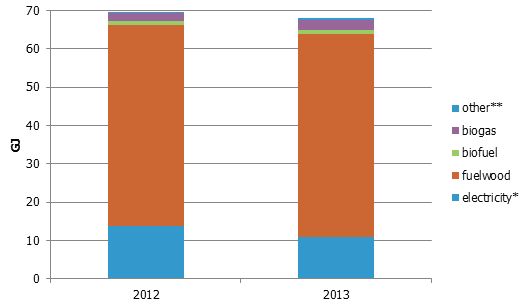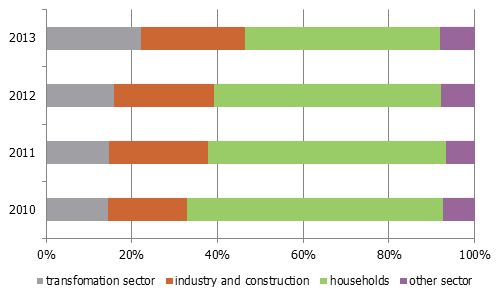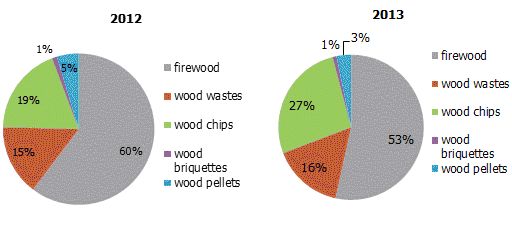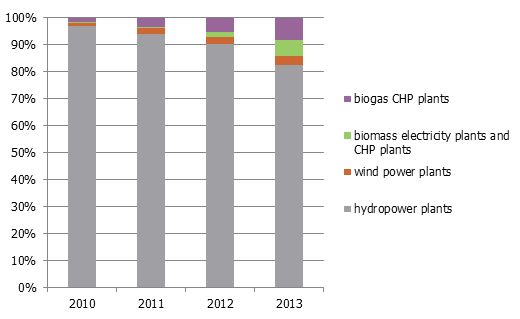Analytics, Energy, Latvia, Markets and Companies
International Internet Magazine. Baltic States news & analytics
Wednesday, 24.04.2024, 04:28
Consumption of renewable sources in Latvia reduced by 2.5% in 2013
 Print version
Print version
This was due to reduction of volume of electricity produced in hydropower plants. In 2013, volume of electricity produced in hydropower plants reached 2912 gigawatt hours (GWh) – 21.9% less than in 2012.
RES takes significant place in Latvia's energy balance. Main RES types are fuelwood and hydro resources, comprising 34% of the total consumption of energy resources in 2013. Wind energy, biogas, biofuel, straw and other biomass are used slightly less commonly. Solar energy currently is used only on a very small scale.
 |
| Consumption of energy resources in 2012 and 2013 |
Data source: Central Statistical Bureau of Latvia
* Hidroelectricity
and wind energy
** Charcoal, straw, other biomass
Share of fuelwood in the use of Latvia's energy resources traditionally has been significant due to its accessibility, thus fuelwood is the most popular renewable energy resource in Latvia. Already for many years fuelwood steady takes fourth part (in 2010 – 25.6%, in 2011 and 2012 – 25.4%, in 2013 – 28%) of the total consumption of energy resources. In its turn, its the share among RES in 2013 comprised 78%.
 |
| Fuelwood consumption by sector, % |
Data source: Central Statistical Bureau of Latvia
Fuelwood consumption has remained practically at the level of the previous year (increase of 1.1%), but in breakdown by sectors changes of consumption level are observed. Main users of fuelwood are households. mainly households use firewood (91%) as it is cheap and available type of fuel in Latvia. In 2010 share of fuelwood in households was 59.8%, but in 2013 – 45.4%.
As share of fuelwood in households reduced, its share in transformation sector in production of heat and production of electricity has increased. Over four years share of fuelwood in transformation sector rose by 7.8% and in 2013 it reached 22.2% of the total consumption in breakdown by sectors. In transformation sector in production of heat and production of electricity mainly wood chips are used (84%). Most significant increase of consumption of fuelwood in transformation sector was observed in 2013 when share of wood chips, compared to 2012, rose by 8.8%. This was due to the new CHP plants, which started their work in 2013, and whose electrical capacity grew by 36.8 MW and reached 45.8 MW.
 |
| Total consumption of fuelwood in 2012 and 2013, % |
Data source: Central Statistical Bureau of Latvia
Firewood has the largest share (more than 50%) of the fuelwood in total consumption – as it was mentioned before, this is the main type of fuel used in households. In 2013 share of firewood reduced by 7%, but share of woodchips rose by 8%, compared to 2012.
 |
| Electricity produced from renewable energy resources |
Data source: Central Statistical Bureau of Latvia
Amount of electricity produced from RES in 2013, compared to 2012, dropped by 14% and reached 3 534 GWh. Share of electricity produced from RES in the total volume produced comprised 56.9%, which is 9.7% less than a year ago.
Majority (more than 80%) of electricity from RES was produced in hydropower plants. There are three active hydropower plants in Latvia with capacity larger than 10 MW. They are Pļaviņas hydropower plant, Rīga hydropower plant and Ķegums hydropower plant. In 2013 these Daugava hydropower plants produced 2 854 GWh electricity or 80.8% of the total electricity produced from RES.
Electrical capacity in power plants and CHP plants using RES
|
|
1990 |
1995 |
2000 |
2010 |
2011 |
2012 |
2013 |
|
|
Electrical capacity (MW) |
||||||
|
Total |
1 487 |
1 508 |
1 515 |
1 22 |
1 642 |
1 701 |
1 755 |
|
Hydropower plants |
1 487 |
1 507 |
1 513 |
1 576 |
1 576 |
1 576 |
1 580 |
|
Wind power plants |
- |
1 |
2 |
30 |
36 |
59 |
67 |
|
Biomass electricity plants and CHP plants |
- |
- |
- |
5 |
5 |
23 |
55 |
|
Biogas CHP plants |
- |
- |
- |
11 |
25 |
43 |
53 |
Over the last years capacity of hydropower plants has not changed significantly , but electric capacity of other electricity plants and CHP plants started to increase significantly. For instance, capacity of wind power plant in 2013, compared to the last year, rose by 13.6%, electrical capacity of biogas CHP plants grew by 23.3%, but electrical capacity of biomass power plants and CHP plants increased by 139%. One of the reasons, affecting development of RES in the production of electricity, is state support allowing to sell electricity within the framework of compulsory purchase.
European Parliament and Council Directive 2009/28/EC on the facilitation of the use of renewable energy resources determine that share of energy from RES in 2020 must comprise at least 40% of the final energy consumption. Gradually Latvia is approaching the aim set. In 2008 share of RES was 29.81%, in 2010– 32.49%, in 2012 – 35.78%, but in2013 it is forecasted that this indicator will rise slightly. Also every Member State in 2020 should ensure that the share of energy produced from RES (biofuel, biogas, electricity produced from RES and consumed in transport) should constitute at least 10% of the final consumption of energy in transport (in 2012 Latvia reached 3.1%).
More detail information on energy sector, of which also on RES, can be found in the CSB database in section "Environment and energy" "Energy".








 «The Baltic Course» Is Sold and Stays in Business!
«The Baltic Course» Is Sold and Stays in Business!

